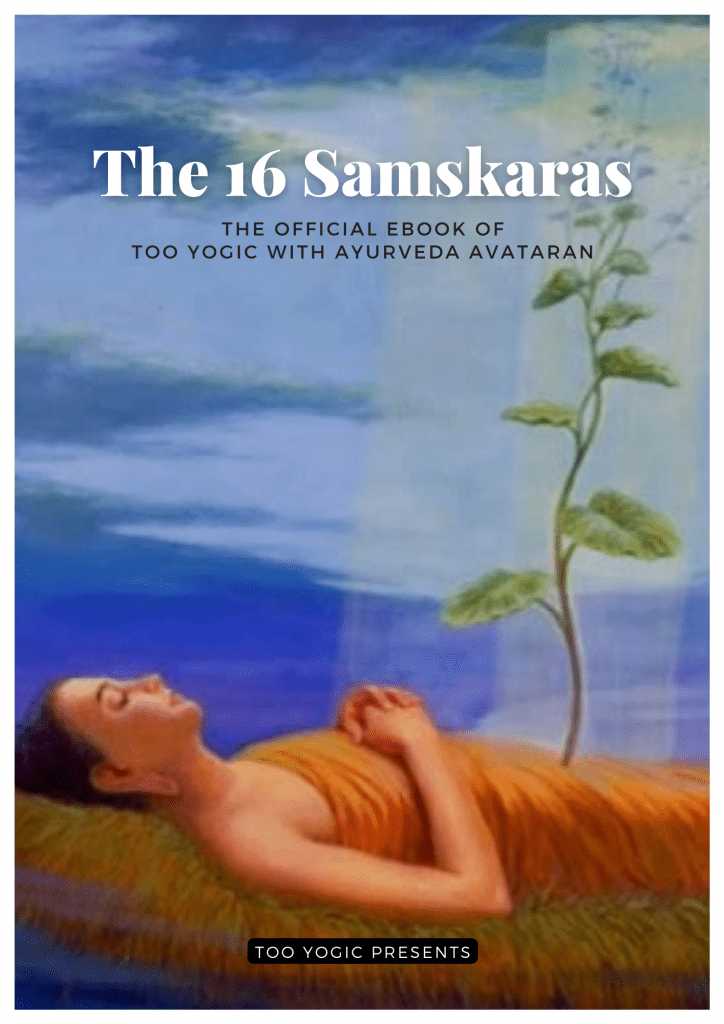
These, 16 are referred to as “Shodasha Samskaras” (Ṣoḍaśa Saṃskāra)
- Intent to have a child ritual, Garbhadhana
- Nurturing the Fetus rite: Pumsavana.
- Parting hair and baby shower, Simantonnayana
- Childbirth ceremony, Jatakarman
- Naming the baby ritual, Namakarana
- Baby’s first outing, Nishkramana
- Baby’s first solid food, Annaprashana
- Baby’s first haircut, Chudakarana
- Baby’s earlobe piercing rite, Karnavedha
- Child’s commencement to knowledge, Vidyarambha
- Child’s entrance into school, Upanayana
- Vedarambha
- Keshanta and Ritusuddhi
- The graduation ceremony, Samavartana
- The wedding rituals, Vivaha
- Cremation ritual, Antyeshti
Garbhadhana also called Garbhalambhanam, literally means attaining the wealth of the womb. It is a private rite of passage, marking the intent of a couple to have a child. It is a ceremony performed before conception and impregnation. In some ancient texts, the word simply refers to the rite of passage where the couple has sex to have a child, and no ceremonies are mentioned. Scholars trace this rite to Vedic hymns, such as those in sections 8.35.10 through 8.35.12 of the Rigveda, where repeated prayers for progeny and prosperity are solemnized,
प्रजां च धत्तं द्रविणं च धत्तम्
bestow upon us progeny and affluence
— Rig Veda 8.35.10 – 8.35.12, Translated by Ralph Griffith
The Vedic texts have many passages, where the hymn solemnizes the desire for having a child, without specifying the gender of the child. For example, the Rigveda in section 10.184 states,
विष्णुर्योनिं कल्पयतु त्वष्टा रूपाणि पिंशतु । आ सिञ्चतु प्रजापतिर्धाता गर्भं दधातु ते ॥१॥
गर्भं धेहि सिनीवालि गर्भं धेहि सरस्वति । गर्भं ते अश्विनौ देवावा धत्तां पुष्करस्रजा ॥२॥
हिरण्ययी अरणी यं निर्मन्थतो अश्विना । तं ते गर्भं हवामहे दशमे मासि सूतवे ॥३॥
May Vishnu construct the womb, may Twashtri fabricate the member, may Prajapati sprinkle the seed, may Dhatri cherish thy embryo;
Sustain the embryo Sinivali, sustain the embryo Saraswati, may the divine Aswins, garlanded with lotuses, sustain thy embryo;
We invoke thy embryo which the Aswins have churned with the golden pieces of Arani (firewood), that thou mayest bring it forth in the tenth month.
— Rig Veda 10.184.1 – 10.184.3, Translated by HH Wilson
The desire for progeny, without mentioning gender, is in many other books of the Rigveda, such as the hymn 10.85.37. The Atharva Veda, similarly in verse 14.2.2, states a ritual invitation to the wife, by her husband to mount the bed for conception, “being happy in mind, here mount the bed; give birth to children for me, your husband”. Later texts, such as the Brihadaranyaka Upanishad, in the last chapter detailing the education of a student, include lessons for his Grihastha stage of life. There, the student is taught, that as a husband, he should cook rice for the wife, and they together eat the food in a certain way depending on whether they wish for the birth of a daughter or a son, as follows,
And if a man wishes that a learned daughter should be born to him and that she should live to her full age, then after having prepared boiled rice with sesamum and butter, they should both eat, being fit to have offspring.
And if a man wishes that a learned son should be born to him and that he should live his full age, then after having prepared boiled rice with meat and butter, they should both eat, being fit to have offspring.
— Brihadaranyaka Upanishad 6.4.17 – 6.4.18, Translated by Max Muller
The different Grhyasutras differ in their point of view, whether the garbhadhana is to be performed only once, before the first conception, or every time before the couple plan to have additional children. To answer this question, the medieval era texts of various schools discussed and offered diverse views on whether the ritual is a rite of passage for the baby’s anticipation in the womb (garbha), or for the wife (kshetra). A rite of passage of the baby would imply that Garbhadhana samskara is necessary for each baby and therefore every time the couple intends to have a new baby, while a rite of passage of the wife would imply a one-time ritual suffices.
To Know Complete
The 16 Samskaras
